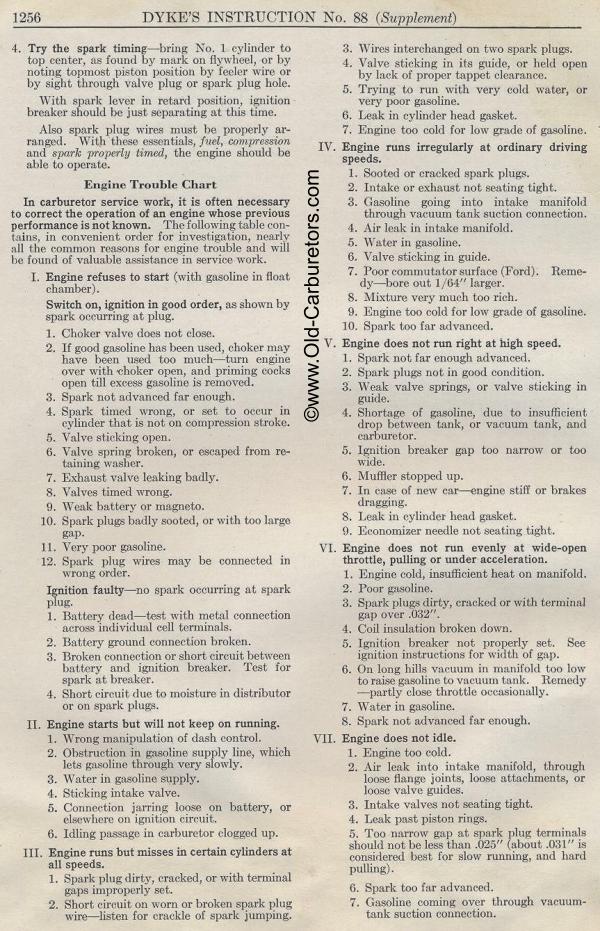Starting Instructions
4. Try the spark timing — bring No. 1 cylinder to
top center, as found by mark on flywheel, or by
noting topmost piston position by feeler wire or
by sight through valve plug or spark plug hole.
With spark lever in retard position, ignition breaker should be
just separating at this time.
Also spark plug wires must he properly arranged. With these essentials,
fuel, compression and spark properly timed, the engine should be
able to operate.
Engine Trouble Chart
In carburetor service work, it is often necessary to correct the
operation of an engine whose previous performance is not known.
The following table contains, in convenient order for investigation,
nearly all the common reasons for engine trouble and will he found
of valuable assistance in service work.
I. Engine refuses to start (with gasoline in float chamber).
Switch on, ignition in good order, as shown by spark occurring
at plug.
1. Choker valve does not close.
2. If good gasoline has been used, choker may have been used too
much —turn engine over with choker open, and priming cocks
open till excess gasoline is removed.
3. Spark not advanced far enough.
4. Spark timed wrong, or set to occur in cylinder that is not on
compression stroke.
5. Valve sticking open.
6. Valve spring broken, or escaped from retaining washer.
7. Exhaust valve leaking badly.
8. Valves timed wrong.
9. Weak battery or magneto.
10. Spark plugs badly sooted, or with too large gap.
11. Very poor gasoline.
12. Spark plug wires may be connected in wrong order.
Ignition faulty — no spark occurring at spark plug.
1. Battery dead — test with metal connection across individual
cell terminals.
2. Battery ground connection broken.
3. Broken connection or short circuit between
battery and ignition breaker. Test for
spark at breaker.
4. Short circuit due to moisture in distributor or on spark plugs.
II. Engine starts but will not keep on running.
1. Wrong manipulation of clash control.
2. Obstruction in gasoline supply line, which
lets gasoline through very slowly.
3. Water in gasoline supply.
4. Sticking intake valve.
5. Connection jarring loose on battery, or elsewhere on ignition
circuit.
6. Idling passage in carburetor clogged up.
III. Engine runs but misses in certain cylinders at all speeds.
1. Spark plug dirty, cracked, or with terminal gaps improperly
set.
2. Short circuit on worn or broken spark plug wire — listen
for crackle of spark jumping.
3. Wires interchanged on two spark plugs.
4. Valve sticking in its guide, or held open by lack of proper
tappet clearance.
5. Trying to run with very cold water, or very poor gasoline.
6. Leak in cylinder head gasket.
7. Engine too cold for low grade of gasoline.
IV. Engine runs irregularly at ordinary driving speeds.
1. Sooted or cracked spark plugs.
2. Intake or exhaust not seating tight.
3. Gasoline going into intake manifold
through vacuum tank suction connection.
4. Air leak in intake manifold.
5. Water in gasoline.
6. Valve sticking in guide.
7. Poor commutator surface (Ford). Remedy — bore out 1/64" larger.
8. Mixture very much too rich.
9. Engine too cold for low grade of gasoline.
10. Spark too far advanced.
V. Engine does not run right at high speed.
1. Spark not far enough advanced.
2. Spark plugs not in good condition.
3. Weak valve springs, or valve sticking in guide.
4. Shortage of gasoline, due to insufficient drop between tank,
or vacuum tank, and carburetor.
5. Ignition breaker gap too narrow or too wide.
6. Muffler stopped up.
7. In case of new car—engine stiff or brakes dragging.
8. Leak in cylinder head gasket.
9. Economizer needle not seating tight.
VI. Engine does not run evenly at wide-open throttle, pulling or
under acceleration.
1. Engine cold, insufficient heat on manifold.
2. Poor gasoline.
3. Spark plugs dirty, cracked or with terminal gap over .032".
4. Coil insulation broken down.
5. Ignition breaker not properly set. See ignition instructions
for width of gap.
6. On long hills vacuum in manifold too low to raise gasoline to
vacuum tank. Remedy —partly close throttle occasionally.
7. Water in gasoline.
8. Spark not advanced far enough.
VII. Engine does not idle.
1. Engine too cold.
2. Air leak into intake manifold, through loose flange joints,
loose attachments, or loose valve guides.
3. Intake valves not seating tight.
4. Leak past piston rings.
5. Too narrow gap at spark plug terminals should not he less than
.025" (about .031" is considered best for slow running,
and hard pulling).
6. Spark too far advanced.
7. Gasoline coining over through vacuum-tank suction connection.
Previous page 1927
Supplement Home Next page 
|
